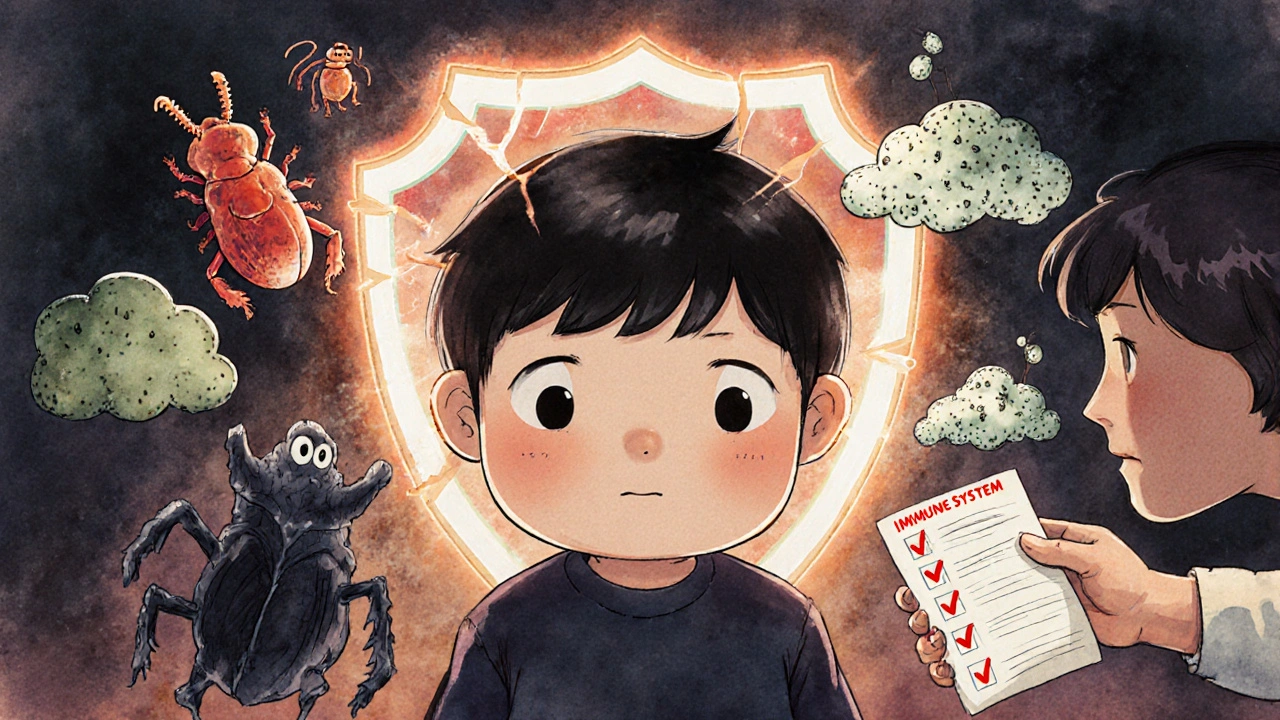Most kids get colds. It’s normal. A preschooler might have 8 to 12 ear infections, runny noses, or coughs in a year. But when those infections don’t stop - when they get worse, don’t respond to antibiotics, or show up in strange places - it’s not just bad luck. It could be a sign something’s wrong with the immune system.
When Is a Recurrent Infection a Red Flag?
Not every infection means immunodeficiency. But certain patterns should make you pause. The American Academy of Allergy, Asthma & Immunology and the European Society for Immunodeficiencies agree on key warning signs. If a child or adult has:
- Four or more ear infections in one year
- Two or more serious sinus infections in 12 months
- Two or more pneumonias within a year
- Deep skin or organ abscesses that keep coming back
- Oral thrush (white patches in the mouth) after age one
- Infections that need IV antibiotics to clear
- Infections caused by unusual organisms like Pneumocystis jirovecii or fungal infections in healthy tissue
- Failure to gain weight or grow normally
- A family history of early deaths from infection or known immunodeficiency
These aren’t just "bad luck." They’re signals. A child with recurrent pneumonia and no response to two full courses of antibiotics isn’t just sensitive to germs - their body may not be able to fight them at all. An adult with chronic fungal skin infections and no diabetes or steroid use? That’s not eczema. That’s a red flag.
What Does a Normal Immune System Look Like?
To spot when something’s broken, you need to know what’s working. A healthy immune system has three layers: physical barriers (skin, mucus), innate defenses (white blood cells that attack anything strange), and adaptive immunity (antibodies and T-cells that learn and remember specific threats). Antibodies - IgG, IgA, IgM - are the body’s targeted weapons. They’re made by B-cells and circulate in the blood to neutralize bacteria and viruses.
But antibody levels change with age. A 3-month-old baby can have an IgG level of 243 mg/dL and be perfectly normal. By age 5, that same child should be near adult levels - 700 to 1,600 mg/dL. If a 7-year-old has an IgG of 420 mg/dL, that’s not "just low." It’s dangerously low for their age. Many doctors miss this because they compare it to adult ranges. That’s a common mistake.
How Do You Test for Immunodeficiency?
Testing isn’t one blood draw. It’s a step-by-step process.
Step 1: Complete Blood Count (CBC) with Differential
This checks your white blood cell count. In kids over one year, lymphocytes below 1,500 cells/μL raise concern. In infants under one, below 3,000 is a red flag. Low lymphocytes mean fewer soldiers in the immune army.
Step 2: Immunoglobulin Levels
Measure IgG, IgA, and IgM. But you must use age-adjusted ranges. IgA is often the first to drop in common variable immunodeficiency (CVID). If IgG is below 400 mg/dL and IgA and/or IgM are also low, that’s a strong indicator of CVID - especially if the patient can’t make antibodies after vaccines.
Step 3: Vaccine Response Test
This is the gold standard. Give a tetanus or diphtheria shot, wait 4 to 6 weeks, then check antibody levels. Protective levels? At least 0.1 IU/mL for tetanus. For pneumococcal vaccine (the polysaccharide kind), you need at least 1.3 μg/mL for each serotype. If the body doesn’t respond, the immune system isn’t learning - and that’s a problem.
Step 4: Flow Cytometry
This test counts T-cells (CD3, CD4, CD8) and B-cells (CD19). In severe combined immunodeficiency (SCID), CD3+ T-cells can be below 1,000 cells/μL in a 2-year-old. In X-linked agammaglobulinemia, B-cells are nearly absent. This test can show if the problem is in the cells themselves, not just the antibodies they make.
Don’t skip the vaccine challenge. A patient with IgG at 450 mg/dL might seem okay - until you find they can’t make a single protective antibody after a vaccine. That’s CVID. And it needs treatment.

What Else Could Be Causing Recurrent Infections?
Before jumping to immunodeficiency, rule out the obvious. Up to 43% of kids with frequent infections have anatomical problems - not immune ones. Cystic fibrosis causes thick mucus that traps bacteria. Chronic sinusitis from deviated septums or nasal polyps creates a breeding ground. Inhaled foreign bodies (like a peanut lodged in a bronchus) can cause recurring pneumonia in one lung.
And don’t forget secondary causes. Medications like long-term steroids or chemotherapy can lower immunity. Autoimmune diseases like lupus or rheumatoid arthritis can cause low immunoglobulins. Certain cancers, especially lymphomas, can mimic immunodeficiency. In fact, up to 30% of adults diagnosed with CVID later turn out to have another condition hiding behind the low antibody levels.
This is why doctors shouldn’t start IVIG (immune globulin therapy) without proof of functional antibody failure. One study found 22% of patients got IVIG unnecessarily - exposing them to risks like headaches, kidney damage, and blood clots - without any real benefit.
What Happens If You Wait Too Long?
Delaying diagnosis isn’t just inconvenient. It’s dangerous.
Children with SCID who aren’t diagnosed before 3.5 months of age have a 31% higher chance of dying. Early diagnosis - through newborn screening - boosts survival to 94%. That’s the difference between a healthy child and a child who spends their first year in isolation, fighting one infection after another.
Even slower-progressing conditions like CVID cause damage over time. Repeated lung infections lead to bronchiectasis - permanent widening of airways that traps mucus and bacteria. Sinus infections scar the tissue. Liver damage from chronic hepatitis can develop from unnoticed viral infections. Growth delays become permanent. The longer you wait, the more damage piles up.
Studies show that when families use the 10-warning-sign checklist, the average time to diagnosis drops from 9.2 years to just 2.1 years. That’s not a small win. That’s life-changing.
What’s New in Testing?
Genetic testing has changed everything. Five years ago, finding the cause of immunodeficiency meant years of guesswork. Now, next-generation sequencing panels like StrataID Immune test 484 immune-related genes in one go. They find the culprit mutation in 35% of suspected cases - nearly double the old rate.
And it’s getting faster. The NIH is running a 5,000-patient study to build AI tools that predict immunodeficiency from routine blood work. Early results? 92% accuracy. Within five years, whole exome sequencing may be the first test - not the last.
But here’s the catch: these tools are expensive and not available everywhere. In low- and middle-income countries, many people still can’t get basic IgG testing. The World Health Organization is now adding flow cytometry to its Essential Diagnostics List to help bridge that gap.
What Should You Do If You Suspect Immunodeficiency?
Don’t wait. Don’t assume it’s "just allergies" or "a weak immune system." Write down:
- How many infections in the last year
- Where they occurred (ears, lungs, skin, sinuses)
- How long antibiotics were used and if they worked
- Any unusual organisms (fungi, rare bacteria)
- Family history of early deaths or immune problems
- Any growth delays or chronic diarrhea
Take this list to your doctor. Ask: "Could this be an immunodeficiency? Can we check IgG, IgA, IgM, and do a vaccine response test?"
If your doctor says no - or doesn’t know - ask for a referral to an immunologist. This isn’t a specialist you see for allergies or asthma. This is someone who understands immune cell counts, vaccine responses, and genetic testing. They’re the only ones who can give you a real answer.
Recurrent infections aren’t normal. They’re a cry from your body saying something’s broken. And if you listen - and act - you can stop the damage before it’s permanent.


